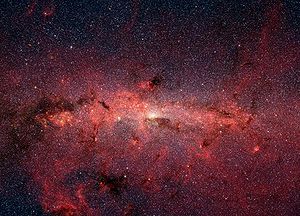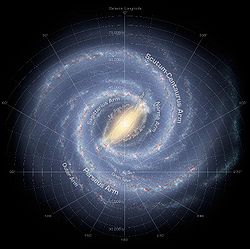Milky Way Galaxy
 From Conservapedia
From Conservapedia 
The Milky Way is a galaxy of type SB (barred spiral galaxy) containing between 200 billion to 400 billion stars, thousands of nebulae and clusters, and an innumerable amount of gas and dust, that is the home of our Solar System. The Milky Way itself is some 100,000 light years in diameter, and some 250-300 thousand light years in circumference,[1] according to some scientists. It is estimated that the mass of the Milky Way is around 1–2 × 1012 solar masses, some 5 to 10 percent of which is interstellar dust and gases.[2]
The English term for Milky Way (and Galaxy in general) has its origin in the Greek Γαλαξίας, or Galaxias, which is from the word for milk, γάλα or gala. According to Greek mythology, the Milky Way is milk that was spilled when Hera was suckling Heracles.
Contents
- 1 History of Observation
- 2 Environment of the Milky Way
- 3 Age of the Milky Way
- 4 Structure of the Milky Way
- 4.1 Galaxy Core
- 4.2 Disk
- 4.3 Halo
- 5 References
History of Observation[edit]
The first person to contend that the Milky Way, as seen in the night sky on Earth, may consist of stars was the Greek philosopher, Democritius (450-370 B.C.).[3] However Aristotle believed the Milky Way was caused by "the ignition of the fiery exhalation of some stars which were large, numerous and close together", that occurred in the upper atmosphere.[4] Aristotle's ideas about the Milky Way were disproved when the Arabian astronomer, Alhazen (965-1037 A.D.) made the first attempt to measure the Milky Way's parallax, determining it to be so remote from the Earth due to having negligible parallax, it was established as celestial in nature and not part of the atmosphere. Many of the other famed astronomers of the medieval Islamic world such as Abū Rayhān al-Bīrūnī, Ibn Bajjah, and Ibn Qayyim Al-Jawziyya came to the conclusion that the Milky Way was made up of many distant stars that were situated very close together.
Observational evidence for the Milky Way being made up of distant stars first came when Galileo Galilei pointed his telescope towards the Milky Way, observing a large amount of faint stars.[5] William Herschel in 1785 was the first to attempt to map out the shape of the Milky Way. He created a diagram based on counting the stars in the different regions of the sky, giving a rough shape of the galaxy with the Solar System near the center. It wasn't until Harlow Shapley in the end of the 19th century was the Milky Way was discovered to be a flat disk with the Solar System far from the center.[6]
Although the Andromeda galaxy was recorded as long ago as the 10th century, and both it and the Magellanic Clouds were known perhaps since ancient times, historically they were not seen as other galaxies, but as nebulae. In 1917, Heber Curtis observed a nova in what was then called the "Great Andromeda Nebula", that along with previous novae found based on subsequent photographic evidence, discovered they were ten magnitudes fainter then novae events in our own galaxy. based on this new evidence, he became a proponent of the "island universe hypothesis" first proposed by Immanuel Kant in 1755, that the spiral nebulae were actually other galaxies.[7] This was later proven by Edwin Hubble in the 1920s, when he was able to determine the distance to the other galaxies though using Cepheid variables located within them as standard candles to determine their distance, showing the "nebulae" were too distant to be part of the Milky Way and hence other galaxies.[8]
Environment of the Milky Way[edit]
The Milky Way is part of a group of tightly bound galaxies called the Local Group, a small cluster of galaxies made up of three large and over 30 dwarf galaxies, itself part of the Virgo Supercluster. It is the second largest galaxy in this cluster after Andromeda, but may be the largest in terms of mass. The Milky way itself is orbited by several dwarf galaxies. The two most famous of these are the Large and Small Magellanic Clouds, which are 179,000 and 210,000 light years distant, respectively. The closest satellite galaxy is actually Canis Major Dwarf, which is only 45,000 light years from the Galactic Center (and 25,000 light years from Earth). There may be even more undiscovered dwarf galaxies orbiting ours, obscured from our own point of view, by our own galaxy.
The Milky Way, as part of the Local Cluster and Virgo Supercluster is moving towards the Great Attractor. The velocity of the Milky Way as it travels is around 552 km/s in respect to the photons of the cosmic microwave background.[9] Within the Local Cluster, the Andromeda galaxy itself is approaching us at 100 to 140 kilometers per second. The two galaxies will collide in some 3 to 4 billion years in the future, eventually forming a single, large elliptical galaxy over the course of a billion years.[10]
Age of the Milky Way[edit]
Many scientists emphasize difficulties with the "big bang" model.[11] Current models of galactic formation in big bang theory cannot explain observed galactic phenomenon,[12] and the cosmic microwave background, hailed as proof of the big bang and used to calculate the age of the Milky Way, has proven to be something else entirely.[13]
The number of supernova remnants in the Milky Way galaxy is consistent with a galaxy which is 7000 years old, not billions of years.[14]
Structure of the Milky Way[edit]

The Milky Way galaxy is roughly divided into three sections: The galaxy core or bulge containing the Galactic Center, the disk, which contains the majority of stars and material of the galaxy and is further divided into spiral arms, and the halo, a diffuse, roughly spherical region of stars around the rest of the galaxy.
Galaxy Core[edit]
The Galaxy Core, also called the Galactic Center or Galactic Bulge, is the rotational center of the Milky Way. It is some 25,000 light years away from our solar system and is the densest and most compact part of our galaxy, mostly consisting of Population II stars. From the vantage point on Earth, it appears as the brightest part of the Milky Way. Much of our knowledge of this region of our galaxy is from observations through gamma ray, X-ray, radio, and infrared satellites. This is because much of the Galactic Center is visibly blocked from our vantage point by intervening interstellar dust.
In the center of the core of the galaxy is a large, complex radio source known as Sagittarius A that is invisible in normal light due to interstellar dust. Here a supernova remnant exists along with a region of ionized hydrogen. Towards the center of this complex is Sagittarius A*, the source of the radio waves and is the location of a supermassive black hole.[15][16] The black hole itself isn't the source of the radio waves, but the large accretion disk around it.
There appears to be no star formation currently in the core of the galaxy, which consists of mostly red stars and globular clusters. However, there is a cluster of 100-200 very young stars. It is possible they are from a star cluster outside the galactic core and migrated inward over time and now orbit near Sagittarius A*.[17] They are sometimes collectively referred to as the paradox of youth as the presence of the supermassive black hole is thought to normally disrupt any star formation. The area immediately surrounding the core of the galaxy though, known as the "5-kpc ring", holds a large percentage of both the galaxy's molecular hydrogen and current star formation.[18]
Disk[edit]
The disk of the galaxy is the location of the spiral arms and holds various Population I stars, including our own sun, ranging from intermediate age stars to very young, hot stars, as well as open clusters, diffuse nebulae, and the interstellar dust and gas responsible for future star formation. Virtually all of the largest and brightest stars (class B and O stars) are found here.
The discovery and mapping of the spiral arms began in the 1950s using radio based observations of the abundant hydrogen gas in the galaxy. This led to the theory that there are four distinct spiral arms known as Norma, Scutum-Centaurus, Sagittarius, and Perseus. Our own solar system located in a partial arm known as the Orion Spur (sometimes called the Orion Arm) between the arms of Sagittarius, and Perseus.[19]
However starting the 1990s when it was discovered using infrared observations that the Milky Way was a barred spiral, the original four armed design was challenged. Later in 2005, the bar in the center of the galaxy was found to extend farther out then previously believed, further bringing into question the prevailing four spiral arm theory. In 2008, new infrared imagery from the Spitzer Space Telescope made the case that the Milky Way has just two major spiral arms, which is known to be common for barred spiral galaxies.[20] These two arms are the Scutum-Centaurus, and Perseus arms, which hold the greatest density of stars and join up with the ends of the central bar of the galaxy. The Sagittarius and Norma arms are now seen as minor arms of the galaxy, filled with gas and groups of young stars.[2]
Our own Solar System travels around the galaxy in an orbit of the center every 225-250 million years (called a galactic year) at around 220 km/s. As the Sun orbits, it oscillates up and down relative to the plane of the galaxy approximately 2.7 times per orbit.
Halo[edit]
The halo is a the region that surrounds the galactic disk and holds Population II stars and globular clusters, of which 158 have been discovered so far.[21] The Galactic Halo itself has a diameter of at least 200,000 light years based on the locations of the globular clusters, although it may extend much further.
The stars that inhabit this sparsely populated portion of the galaxy tend to have retrograde or highly inclined orbits. Many of these stars may have been acquired from smaller galaxies that have pulled into and since merged with the Milky Way. There is no star formation out in the halo and the region appears to be free of interstellar dust.
In addition to the inner, visible portion of the halo, there is the much larger region known as the dark halo or extended halo. This region is believed to hold a large amount of dark matter, the presence of which can only be inferred through its gravitational influence in the rotation of the galaxy.[22]
References[edit]
- ↑ http://www.space.com/milkyway/
- ↑ 2.0 2.1 http://www.daviddarling.info/encyclopedia/G/Galaxy.html
- ↑ http://www.dispatch.com/live/content/now/stories/2007/07/stars.html
- ↑ http://plato.stanford.edu/entries/ibn-bajja/
- ↑ http://www-gap.dcs.st-and.ac.uk/~history/Biographies/Galileo.html
- ↑ http://www.scientificamerican.com/article.cfm?id=how-did-scientists-determ
- ↑ http://adsabs.harvard.edu/abs/1988PASP..100....6C
- ↑ http://adsabs.harvard.edu/cgi-bin/bib_query?1929ApJ....69..103H
- ↑ http://adsabs.harvard.edu/cgi-bin/nph-bib_query?bibcode=1993ApJ...419....1K
- ↑ http://www.news.utoronto.ca/bin/000414b.asp
- ↑ http://www.pathlights.com/ce_encyclopedia/Encyclopedia/03-ss5.htm
- ↑ http://www.answersingenesis.org/creation/v26/i3/galaxies.asp
- ↑ http://www.moondaily.com/reports/Big_Bang_Afterglow_Fails_An_Intergalactic_Shadow_Test_999.html
- ↑ Davies, Keith. Distribution of supernova remnants in the galaxy. Creation Discovery Project, 1994
- ↑ http://news.bbc.co.uk/2/hi/science/nature/7774287.stm
- ↑ http://cass.ucsd.edu/public/tutorial/MW.html
- ↑ http://www.astro.ucla.edu/~ghezgroup/gc/publications/yso.shtml
- ↑ http://www.bu.edu/galacticring/new_introduction.htm
- ↑ http://www.space.com/scienceastronomy/080603-aas-spiral-arms.html
- ↑ http://adsabs.harvard.edu/abs/2008ASPC..387..375B
- ↑ http://www.seds.org/~spider/spider/MWGC/mwgc.html
- ↑ http://www.daviddarling.info/encyclopedia/G/galhalo.html
| |||||||||||||||||
Categories: [Astronomy] [Galaxies]
↧ Download as ZWI file | Last modified: 03/15/2023 00:54:18 | 35 views
☰ Source: https://www.conservapedia.com/Milky_Way_Galaxy | License: CC BY-SA 3.0
 ZWI signed:
ZWI signed: KSF
KSF